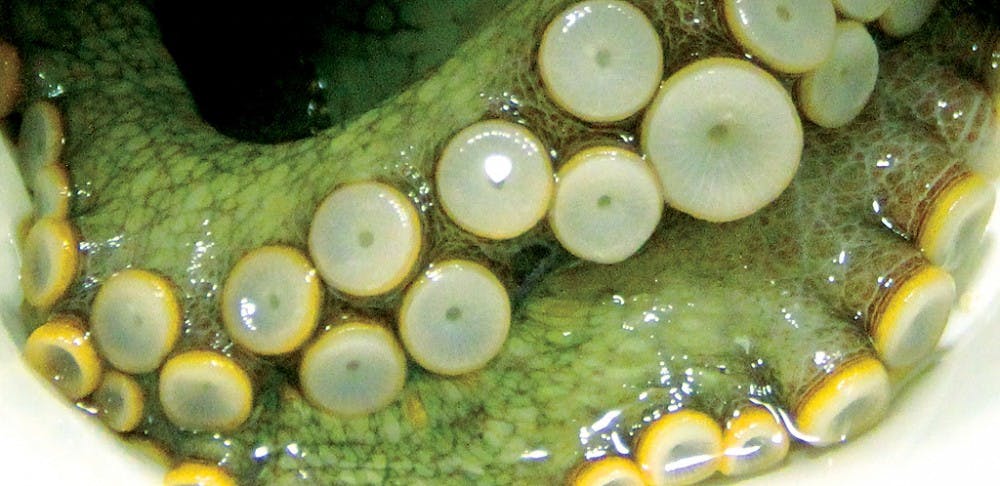It’s a basic rule of biology that the cute and fuzzy critters get all the attention—just compare search results for “Duke lemur” and “Duke insect.” Towerview has been no exception, with our latest issue including one article about lemurs, one article about wild horses and zero articles about an animal with more than four legs. Well, now we’re going to give the not-so-fuzzy creatures their time in the spotlight. Some of them captivated our imagination, though others sent our photographer into a fit of terrified hysterics. Take a look at Science Drive’s most unusual animals…
tobacco hornworms, Manduca sexta
These plump, green caterpillars would eat each other if Fred Nijhou, professor of biology, didn’t keep them in separate plastic containers. In their larval stage, the tobacco hornworms eat rapidly and indiscriminately. “They’re just eating machines, and they’ll eat anything they run into,” says Nijhout. Their goal is to grow as much as possible in a short period of time. Nijhout studies this growth and the hormones that spur and stop it. His research suggests that oxygen is a key factor. “That’s their size mechanism—growing too big for their oxygen supply,” he says. This might explain why giant insects used to roam the earth in prehistoric eras, when oxygen was more highly concentrated in the atmosphere.
It wasn’t quite a prehistoric era when Nijhout started his research more than 30 years ago, but things were still different for the tobacco hornworm. Its primary source of food, tobacco, was one of the region’s most plentiful crops. Since then, both tobacco and the hornworm have become less common, but hornworms still thrive on garden-variety tomato plants, close relatives of tobacco.
caribbean anoles, Anolis spp.
When Manuel Leal, assistant professor of biology, grew up in Puerto Rico, he could find these brightly colored lizards in his backyard. Now, he keeps them in temperature-controlled chambers on the second floor of the Biological Sciences Building. Anoles have very high visual acuity, allowing them to perceive color and motion far better than humans. One of the ways they use this skill involves the dewlap, a retractable flap of skin beneath the neck. The dewlap is more pronounced in males, and they use it to attract females and ward off competing males. In researching anole communication, Leal has found that the lizards, which can observe light at higher frequencies than humans, display UV patterns on their dewlaps. “Not only do they have sensitivity,” he says, “They also seem to use it.”
sea urchins, Strongelyocentrotus spp.
Before they develop sharp spines, a tough outer shell and hundreds of suction-cupped tube feet, sea urchin embryos have much in common with human embryos. David McClay, professor of biology, takes advantage of this similarity to learn about the process of embryonic development. “We work at a molecular level to figure out how cells become organisms,” he says. Over the course of 40 years at Duke, McClay and his lab have identified multiple genes responsible for forming anatomical patterns. He is particularly interested in a process by which embryonic cells become migratory, much like cancer cells in a malignant tumor. If McClay can better understand this process in sea urchins, the results might be applied to cancer treatment in humans.
common cuttlefish, Sepia oficinalis, and California two-spot octopuses, Octopus bimaculoides
Cephalopods are well known as masters of disguise. They can drastically alter their color and texture to match their surroundings. Sarah Zylinski, a postdoctoral associate in biology, studies this camouflaging ability to understand how cephalopods view the world. She primarily works with squid-like cephalopods called cuttlefish. By researching how the cuttlefish blend into different backgrounds, she can determine if they perceive incomplete shapes as obscured wholes, like humans, or as separate parts, like most invertebrates. “Cuttlefish tell us what they can see through the body patterns they display,” she says. So far, it appears that cuttlefish are more similar to humans in their perception, which is surprising because they are evolutionarily distant.
Zylinski also researches octopuses, and she keeps two of them—Donald and Moana—in the same room as the cuttlefish. Notorious escape artists, the octopuses have to be kept in enclosures surrounded with mesh sacks so that they don’t get out and wander into other tanks. Both cuttlefish and octopuses are also known for their ability to spray ink as a defense mechanism. One cuttlefish did not hesitate to demonstrate this ability when this reporter got too close.
swamp sparrows, Melospiza georgiana, and song sparrows, Melospiza melodia
Although most people, including many dedicated birdwatchers, disregard sparrows as nothing more than “little brown birds,” Steve Nowicki, professor of biology, finds them fascinating. He is especially interested in their songs and how singing relates to other aspects of evolution. Zebra finches are typically used for this sort of work, but Nowicki prefers sparrows because he can study them in the wild. “You really need to work with a real animal out there in the real world,” he says.
Because Nowicki also serves as the dean and vice provost of undergraduate education, he doesn’t spend as much time as he used to on his research. His wife, Susan Peters, an associate in research, runs the lab from day to day. She explains that the lab has linked a male sparrow’s repertoire size—the number of songs he can sing— to his cognitive abilities. In addition to the practical benefits of studying sparrow songs, Nowicki also appreciates them on an aesthetic level. “They’re just gorgeous songs,” he says.
Get The Chronicle straight to your inbox
Signup for our weekly newsletter. Cancel at any time.

